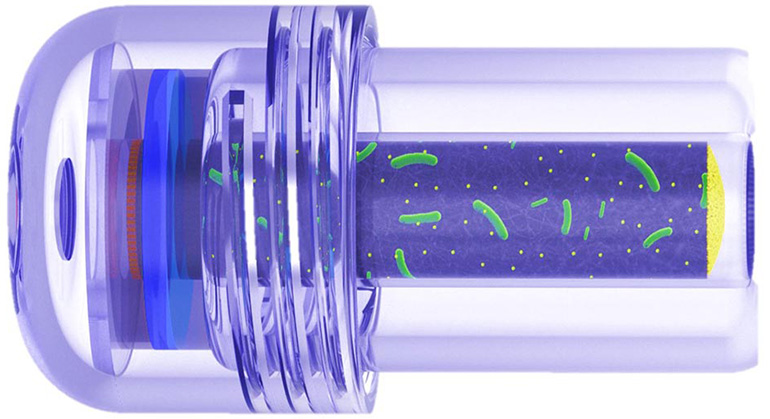Researchers at Binghamton University have developed a microbial fuel cell that can power ingestible devices, such as cameras, that can detect health issues in the gastrointestinal tract, and specifically within the small intestine. The fuel cell contains dormant Bacillus subtilis endospores that only germinate and become active when they encounter nutrient-rich intestinal fluid. Another check on activity is a pH-sensitive membrane that only allows the fuel cell to activate when it reaches the neutral pH of the small intestine. The technology may provide an alternative to conventional batteries that could pose a health risk if they began to leak or became damaged in the body.
How can we monitor the gut? One option is an ingestible camera in the form of a pill that once swallowed will pass down the gastrointestinal tract and provide invaluable images of those difficult-to-reach areas. While this solution is elegant, finding a way to reliably and safely power the device can be tricky. Conventional batteries can pose a safety risk, and if the device is intended to remain the GI tract for a while they could run out of power. Another option is to use the nutrient-rich fluid in the intestine to power a so-called biobattery.
“There are some regions in the small intestine that are not reachable, and that is why ingestible cameras have been developed to solve this issue,” said Seokheun “Sean” Choi, one of the lead developers of the new biobattery. “They can do many things, such as imaging and physical sensing, even drug delivery. The problem is power. So far, the electronics are using primary batteries that have a finite energy budget and cannot function for the long term.”

In this new paradigm, nutrient-rich intestinal fluid enters the biobattery, and then the bacteria within begin to feed on it, creating small amounts of electricity in the process. So far, the technology is at the proof of concept stage, and the researchers have tested it by submerging a biobattery in simulated intestinal fluid, and showed that the battery could produce a current density of 470 µA cm−2 and a power density of 98 µW cm−2, suggesting that it has potential to energize ingestible devices.
However, there is still more work to do before the technology is suitable for testing in humans. The researchers are working to improve the amount of electricity the system can produce so that they can equip biobattery-powered devices with more advanced features. They have already cleverly made the system specific for the small intestine using pH sensitive materials.
“How do you make your micro-fuel cell selectively work in the small intestine? We use a pH-sensitive membrane that requires certain conditions to activate,” said Choi. “When you look at our gastrointestinal tract, the esophagus has a neutral pH, the same as the small intestine, but the transit time is only 10 seconds. It will not activate in this area, and it will never work in the stomach because the stomach has a very low pH. It only works in the small gut.”
Study in advanced energy materials: A Biobattery Capsule for Ingestible Electronics in the Small Intestine: Biopower Production from Intestinal Fluids Activated Germination of Exoelectrogenic Bacterial Endospores
